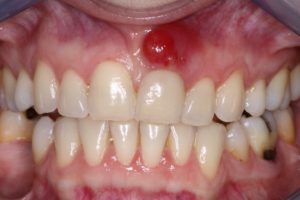 Education cysts on the gum - the phenomenon is not rare. It can arise both in adults and in children. Its main danger is that at the first stages of its development it is almost imperceptible and does not cause any inconvenience to a person.
Education cysts on the gum - the phenomenon is not rare. It can arise both in adults and in children. Its main danger is that at the first stages of its development it is almost imperceptible and does not cause any inconvenience to a person.
The maximum that a patient can feel is a slight tingling of the gum area and a slight reddening. But these symptoms already serve as an excuse for a visit to the dentist.
Contents of
- What is it?
- How to identify the disease?
- What triggers a violation?
- Possible consequences
- How to get rid of the problem?
What is it?
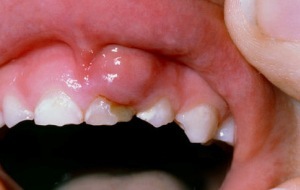
The photo shows the cyst on the gums.
. The cyst that forms on the gum is a neoplasm that has an inflammatory character and is filled from the inside with purulent masses.
This is a kind of capsule with round or oval outlines. Its outer layer is formed by a connective tissue, and the inner layer is covered with a complex multilayer epithelium. The cyst can take completely different sizes, sometimes reaching a few centimeters.
This formation occurs on the gum, or rather, in the area of the roots of the tooth. Development begins inside soft tissues almost asymptomatically. Only after a while the cyst appears on the surface and is filled with pus.
How to identify the disease?
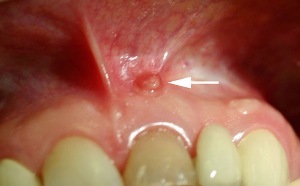
The cyst is a rather insidious disease. At the initial stage of development, even when examining the dentist, it is very difficult to identify it. Initially, her growth is not absolutely no symptomatology, she does not manifest herself at all.
During this period, the neoplasm can be detected only by radiographing the teeth. In the picture, the dentist can clearly see the incipient cyst.
But on a number of symptoms it is quite possible to notice the development of this disease, although not at the very initial, but still at an early stage:
- occurrence of unpleasant sensations in the gum with biting food or chewing it;
- feeling of heaviness in the root area of the tooth;
-
 Periodic overgrowth of uncomfortable sensations in pain, especially during meals;
Periodic overgrowth of uncomfortable sensations in pain, especially during meals; - obstructed mouth opening;
- gradual overgrowth of periodic aching pain into a permanent acute pain;
- occurrence on the gum in the root area of the tooth of a small tubercle, with time increasing in size and filling with liquid;
- sensation of weakness, slight malaise, unreasonable fever, enlarged lymph nodes;
- appearance of a flux or fistula.
Having found out one of these symptoms, and even more a few, immediately need to visit a specialist to prescribe the necessary treatment. This can not be delayed, since a neglected cyst can lead to the loss of a problem tooth and other more serious consequences.
What triggers a violation?
When a disease occurs, it is very important to know its causes, in order to prevent this in the future.
In the overwhelming majority of cases, the appearance of this malignancy results in improper, poor-quality dental treatment and, as a consequence, getting into the root canals of infection.
There are four most common causes of cyst development on the gums:
-
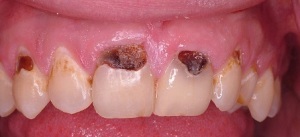
Cervical caries
An established form of caries or pulpitis in the absence of timely treatment. In this situation, it is likely the emergence of periodontitis. At the same time in the upper part of the root of the problem tooth there is a focus of inflammation with the formation of purulent masses. As a result of a fairly large accumulation of pus, it begins to tend to the surface of the gum. As a consequence, a capsule filled with liquid is formed on the mucosa.
- Inadequately sealed tooth root canals .Timely dental treatment does not preclude the appearance of cysts. Very often the canals in the roots of the tooth are not sealed properly enough, as a result of which a cavity is formed in their uppermost part. After a while in this place begins to develop infection with a subsequent exit beyond the tooth and lesions of gum tissue. And it can happen as soon after the sealing, and in a few years. In the absence of treatment, the inflammation continues, and purulent masses are formed, seeking an outlet outward. As a result, a cyst appears on the surface of the gum.
-
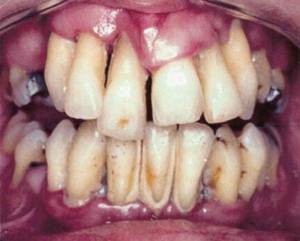
Periodontal disease
A foci of infection can occur as as a consequence of the perforation of the tooth channel .This happens, as a rule, as a result of improper treatment, non-compliance with the rules for cleaning channels, incorrect installation of the pin. All these factors can also lead to the formation of a very favorable environment for the development of pathogenic bacteria, inflammation of soft tissues and the appearance of pus.
- The emergence of the cyst on the background of progressive periodontitis .Periodontal pockets appear on the gums, followed by filling with purulent masses. If there is no possibility of an outflow of pus in these cavities, an abscess develops, and then a cyst arises.
Other possible causes of cystic formation are:
-
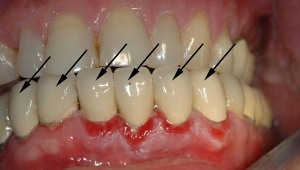
Inflammation of the gingiva under the crowns
Presence of a chronic nasopharyngeal disease, for example, sinusitis, runny nose or the like;
- weakened immunity;
- inflammatory process under a tooth-set crown;
- jaw injury;
- is a complicated eruption of wisdom teeth.
Possible consequences
The cyst at the root of the tooth is dangerous first of all for the asymptomatic onset of the disease. And at the first signs of a neoplasm, most people do not rush to the dental clinic. But this negligence can lead to serious consequences:
- getting pus from the ruptured cyst to the periosteum and the development of phlegmon;
-
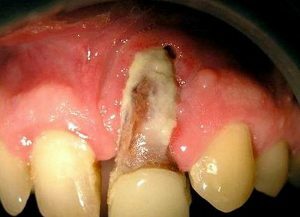
Osteomyelitis of the jaw
formation of a pouch with pus in the cervical space - flux;
- inflammation in the jawbone with the threat of spreading and other elements of the skeleton;
- development of periodontitis followed by the formation of the fistula;
- bone marrow lesion - osteomyelitis;
- root destruction, interruption of communication with the periosteum and tooth loss;
- overgrowing cystic formation into a malignant tumor;
- chronic diseases of various organs( throat, nose, liver).
Diseases arising as a result of an untreated cyst in time cause much more pain and require a longer and more complex treatment than a primary disease.
Therefore, if there is education on the gums, you should visit a doctor as soon as possible.
How to get rid of the problem?
The choice of method of treatment directly depends on the stage of the disease, and it should be determined by a dentist. But not all people rush to seek specialized help. In this case, it is possible to alleviate the situation at home by resorting to folk remedies:
-
 rinsing with a solution of salt or soda;
rinsing with a solution of salt or soda; - broth of chamomile, calendula, sage, oak bark;
- alcohol horseradish or ficus tincture.
Treatment of a cyst in a dental clinic, depending on the severity of the disease, is possible in three ways:
- therapeutic;
- surgical;
- laser.
More information about the treatment of root canal cysts you can read in this article What is the cyst of the tooth and how to treat it.
More details about this problem can be found in the video:
Cystic education on the gums is a very insidious disease, requiring immediate treatment when the very first signs appear. Therefore, at the slightest sign of a violation, you need to contact the dentist as soon as possible.
This will significantly reduce the time of recovery and exclude the development of more serious diseases.
